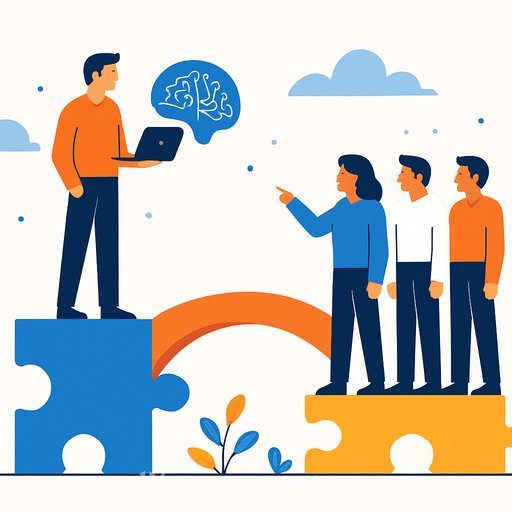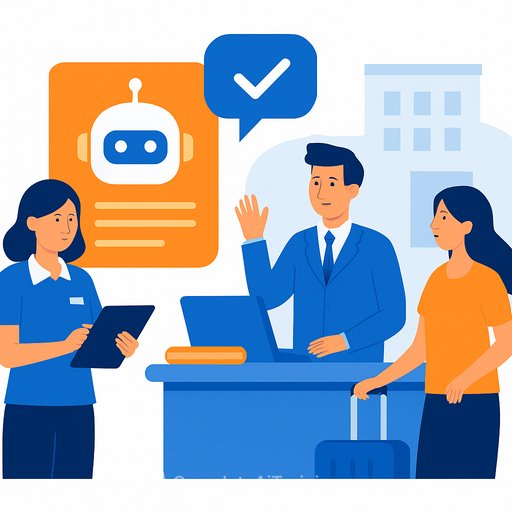From HR Manager to Human-AI Strategist
HR prepares everyone else for change. The question is: who prepares HR? AI has moved from buzzword to baseline, altering how we source, assess, develop, and retain talent.
Resume screening is automated. Attrition risks are forecasted. Learning paths are personalized. Chatbots handle FAQs, and sentiment tools detect burnout before it spreads. HR now sits at the center of business transformation-and faces a skills gap inside the skills gap.
The Hidden Risk: The Skills Gap Inside HR
Automation is taking over repeatable HR tasks-screening, scheduling, compliance, benefits administration. Advanced models already predict flight risks and recommend retention strategies.
If HR does not upskill, it risks being sidelined by the very shift it is driving. The role must move from process-heavy administration to tech-enabled strategy.
Why Traditional HR Education Falls Short
- Curricula focus on compliance, policy, and process-light on data fluency, AI literacy, and bias awareness.
- Academia updates slower than tech evolves, so content lags market reality.
- Graduates enter with yesterday's skills; veterans must unlearn habits while running daily operations.
New Tools Require New Thinking
HR tech used to digitize tasks. Now it informs strategy. Predictive analytics, AI sourcing, and NLP for sentiment turn HR into a forward-looking function.
Tools are evolving faster than the mindsets required to use them. The shift is from enforcing policy to interpreting data and influencing business decisions.
From Policy Enforcer to Strategic Data Interpreter
Modern HR translates signals into action. Correlate leadership behaviors with retention. Tie learning investments to productivity gains. Pressure-test workforce scenarios before committing budgets.
That requires comfort with metrics, causal thinking, and evidence-based recommendations to the C-suite.
Core Skills for AI-Ready HR
- Data Fluency: Read, question, and work with data sets to spot patterns and causal clues-no PhD needed, but clear thinking required.
- AI Literacy: Know how models work, where they break, and how bias slips in. Treat outputs as inputs to judgment, not verdicts.
- Systems Thinking: See the org as an interconnected system. A change in hiring affects engagement, performance, and mobility.
Roles You Will Hire or Become
Human-AI Strategist
Connect human capability with machine capability. Translate algorithmic outputs into practical decisions. Build guardrails so AI augments managers, not replaces them.
Own workflow design, tool selection, and the operating model for human-machine collaboration.
People Analytics Architect
Design the data foundation: pipelines, models, and dashboards that explain, predict, and simulate workforce outcomes. Move beyond headcount and turnover to scenario modeling and skill gap forecasting.
Set data governance for privacy, accuracy, and ethical use to maintain trust in HR decisions.
Employee Experience Designer
Craft cohesive physical and digital experiences across the employee journey. Blend org psychology with UX to reduce friction and increase clarity.
Use AI for personalization-career paths, learning, and benefits-while keeping the culture human.
Trust and Ethics Officer
Audit algorithms for fairness, document how models are trained, and align with emerging regulation. Be the conscience of HR tech-transparent, explainable, and humane.
Consistent standards build credibility with candidates, employees, and regulators.
The New Playbook: How to Skill Up Fast
Micro-Credentials
AI evolves on a 3-6 month cycle. Stack short, targeted credentials across AI ethics, data visualization, prompt quality, and bias detection. Learn, apply, repeat.
Explore focused programs and certifications that map to real HR workflows: Courses by job and popular certifications.
Cross-Functional Projects
Pair HR with IT, Finance, and Operations to deliver real outcomes. Implement a sentiment analysis pilot. Co-build a workforce planning model. Run a pay equity analysis with explainable AI.
You gain data skills; they gain context. The business gains momentum.
AI Sandboxes
Create safe environments to test models, prompts, and workflows without real-world impact. Simulate hiring spikes, budget cuts, or skill shortages. Document lessons and roll out in waves.
Embed Tech Fluency in Daily Work
- Use weekly talent dashboards to spot risk and momentum.
- Forecast L&D budgets with predictive indicators.
- Analyze exit interviews with NLP to find pattern shifts.
- Run quarterly reviews of model performance and bias.
Culture, Trust, and Communication
Model Curiosity and Adaptability
Show your work. Pilot a tool, share outcomes, and iterate in public. Curiosity scales faster than mandates.
Lead with Emotional Intelligence
AI introduces anxiety-jobs, surveillance, and control are common fears. Hold open forums. Explain what data is used, why, and where human oversight sits.
Psychological safety is a prerequisite for adoption.
Make AI Decisions Transparent
- Explain how models are selected, trained, and tested for bias. Consider guidance like the NIST AI Risk Management Framework.
- Publish privacy standards and data retention timelines.
- Document cases where human judgment overrode a model-and why.
Build AI Literacy Across the Org
Offer AI 101 sessions, short workshops, and role-specific labs. The more people grasp how systems work, the more responsibly they use them.
Keep Learning Alive
Run quarterly innovation challenges. Reward AI-enabled improvements. Pair tech-savvy staff with AI newcomers for mentoring.
Tech-Enhanced HR in Practice
Use Automation to Buy Back Time
Automate screening, scheduling, and FAQs to free capacity for workforce strategy, succession, and culture. More depth, less busywork.
Automation is a force multiplier when you redirect time to high-value human work.
Design Human-Centric AI Workflows
- Transparency: Be clear on how recommendations are generated and used.
- Opt-in flexibility: Offer a human path for sensitive topics.
- Feedback loops: Capture user input and tune systems continuously.
Scale with a High-Tech, High-Touch Model
AI can personalize learning for thousands. Keep human touchpoints where meaning matters-career coaching, sensitive feedback, and well-being conversations.
Scale systems, not empathy.
30-60-90 Day Action Plan
- 30 days: Audit your HR tech stack and data flows. Define three measurable use cases (e.g., attrition risk, quality of hire, skills mapping). Draft an AI ethics and oversight policy.
- 60 days: Launch one sandbox pilot. Stand up a weekly talent dashboard. Earn one micro-credential in AI for HR.
- 90 days: Expand to a cross-functional project. Formalize model monitoring and bias checks. Share outcomes with the C-suite and set next-quarter targets. Explore additional training paths: latest AI courses.
Call to Action
Invest in yourself at the same level you invest in your people. Upskill in data, AI, and systems thinking while doubling down on trust and empathy.
The HR leader who can read a dashboard and read the room will set the standard for this decade.
Conclusion: Smart, Caring, Tech-Enhanced HR
The future of HR is a blend of intelligence and empathy. Use AI to speed insight and scale personalization; use human judgment to add context, nuance, and care.
Your edge will come from thinking with machines and leading as a human. Build the capability, set the guardrails, and lead your organization with clarity and courage.
Your membership also unlocks:






